Prevalence of Depression and Fish Consumption among First Year Spanish University Students: UniHcos Project
Abstract
1. Introduction
2. Materials and Methods
- Employment status: Unemployed (studying and not seeking employment, studying and seeking employment), employed (studying and working part-time, studying and working full-time);
- Living arrangements: Parents, roommates (roommates/friends), partner (with partner, with children), alone. To facilitate data comparison, those who lived with others were grouped into the “accompanied” category;
- Location: Universities in the north (Cantabria, Castilla-La Mancha, León, Vigo, Salamanca, and Valladolid) and universities in the south (Granada, Jaén, Huelva, Alicante, and Valencia);
- Marital status: The categories of “separated” and “divorced” were combined.
Statistical Analysis
3. Results
3.1. General Characteristics of Surveyed Students
3.2. Characteristics of Students
3.3. Description of Fish Intake According to the Distribution of Students
3.4. Compliance with Fish Consumption Recommendations in Depressed and Non-Depressed Individuals Based on Population Characteristics
3.5. Analysis of the Evaluation of the Influence of Fish Intake According to Population Characteristics
4. Discussion
Limitations
5. Conclusions
Supplementary Materials
Author Contributions
Funding
Institutional Review Board Statement
Informed Consent Statement
Data Availability Statement
Acknowledgments
Conflicts of Interest
References
- World Health Organization. Depressive Disorder (Depression); World Health Organization: Geneva, Switzerland, 2023. [Google Scholar]
- Herrman, H.; Kieling, C.; McGorry, P.; Horton, R.; Sargent, J.; Patel, V. Reducing the Global Burden of Depression: A Lancet–World Psychiatric Association Commission. Lancet 2019, 393, e42–e43. [Google Scholar] [CrossRef]
- Pérez-Padilla, E.A.; Cervantes-Ramírez, V.M.; Hijuelos-García, N.A.; Pineda-Cortés, J.C.; Salgado-Burgos, H. Prevalencia, Causas y Tratamiento de la Depresión Mayor. Rev. Bioméd. 2017, 28, 73–98. [Google Scholar] [CrossRef]
- Auerbach, R.P.; Mortier, P.; Bruffaerts, R.; Alonso, J.; Benjet, C.; Cuijpers, P.; Demyttenaere, K.; Ebert, D.D.; Green, J.G.; Hasking, P. WHO World Mental Health Surveys International College Student Project: Prevalence and Distribution of Mental Disorders. J. Abnorm. Psychol. 2018, 127, 623. [Google Scholar] [CrossRef]
- Zielińska, M.; Łuszczki, E.; Michońska, I.; Dereń, K. The Mediterranean Diet and the Western Diet in Adolescent Depression-Current Reports. Nutrients 2022, 14, 4390. [Google Scholar] [CrossRef]
- World Health Organization. COVID-19 Pandemic Triggers 25% Increase in Prevalence of Anxiety and Depression Worldwide; World Health Organization: Geneva, Switzerland, 2022. [Google Scholar]
- Luo, W.; Zhong, B.; Chiu, H.F. Prevalence of Depressive Symptoms among Chinese University Students Amid the COVID-19 Pandemic: A Systematic Review and Meta-Analysis. Epidemiol. Psychiatr. Sci. 2021, 30, e31. [Google Scholar] [CrossRef] [PubMed]
- Wang, X.; Hegde, S.; Son, C.; Keller, B.; Smith, A.; Sasangohar, F. Investigating Mental Health of US College Students during the COVID-19 Pandemic: Cross-Sectional Survey Study. J. Med. Internet Res. 2020, 22, e22817. [Google Scholar] [CrossRef] [PubMed]
- Wang, C.; Wen, W.; Zhang, H.; Ni, J.; Jiang, J.; Cheng, Y.; Zhou, M.; Ye, L.; Feng, Z.; Ge, Z. Anxiety, Depression, and Stress Prevalence among College Students during the COVID-19 Pandemic: A Systematic Review and Meta-Analysis. J. Am. Coll. Health 2021, 1–8. [Google Scholar] [CrossRef] [PubMed]
- Oliveira Carvalho, P.; Hülsdünker, T.; Carson, F. The Impact of the COVID-19 Lockdown on European Students’ Negative Emotional Symptoms: A Systematic Review and Meta-Analysis. Behav. Sci. 2021, 12, 3. [Google Scholar] [CrossRef] [PubMed]
- Elharake, J.A.; Akbar, F.; Malik, A.A.; Gilliam, W.; Omer, S.B. Mental Health Impact of COVID-19 among Children and College Students: A Systematic Review. Child. Psychiatry Hum. Dev. 2022, 54, 913–925. [Google Scholar] [CrossRef] [PubMed]
- Taha, S.A.; Matheson, K.; Anisman, H. H1N1 Was Not All That Scary: Uncertainty and Stressor Appraisals Predict Anxiety Related to a Coming Viral Threat. Stress Health 2014, 30, 149–157. [Google Scholar] [CrossRef] [PubMed]
- Yeung, N.C.; Lau, J.T.; Choi, K.C.; Griffiths, S. Population Responses during the Pandemic Phase of the Influenza A (H1N1) pdm09 Epidemic, Hong Kong, China. Emerg. Infect. Dis. 2017, 23, 813. [Google Scholar] [CrossRef]
- Hawryluck, L.; Gold, W.L.; Robinson, S.; Pogorski, S.; Galea, S.; Styra, R. SARS Control and Psychological Effects of Quarantine, Toronto, Canada. Emerg. Infect. Dis. 2004, 10, 1206. [Google Scholar] [CrossRef] [PubMed]
- Peng, E.Y.; Lee, M.; Tsai, S.; Yang, C.; Morisky, D.E.; Tsai, L.; Weng, Y.; Lyu, S. Population-Based Post-Crisis Psychological Distress: An Example from the SARS Outbreak in Taiwan. J. Formos. Med. Assoc. 2010, 109, 524–532. [Google Scholar] [CrossRef] [PubMed]
- Jalloh, M.F.; Li, W.; Bunnell, R.E.; Ethier, K.A.; O’Leary, A.; Hageman, K.M.; Sengeh, P.; Jalloh, M.B.; Morgan, O.; Hersey, S. Impact of Ebola Experiences and Risk Perceptions on Mental Health in Sierra Leone, July 2015. BMJ Glob. Health 2018, 3, e000471. [Google Scholar] [CrossRef] [PubMed]
- Ramón-Arbués, E.; Gea-Caballero, V.; Granada-López, J.M.; Juárez-Vela, R.; Pellicer-García, B.; Antón-Solanas, I. The Prevalence of Depression, Anxiety and Stress and their Associated Factors in College Students. Int. J. Environ. Res. Public Health 2020, 17, 7001. [Google Scholar] [CrossRef] [PubMed]
- Acharya, L.; Jin, L.; Collins, W. College Life is Stressful today–Emerging Stressors and Depressive Symptoms in College Students. J. Am. Coll. Health 2018, 66, 655–664. [Google Scholar] [CrossRef] [PubMed]
- Lassale, C.; Batty, G.D.; Baghdadli, A.; Jacka, F.; Sánchez-Villegas, A.; Kivimäki, M.; Akbaraly, T. Healthy Dietary Indices and Risk of Depressive Outcomes: A Systematic Review and Meta-Analysis of Observational Studies. Mol. Psychiatry 2019, 24, 965–986. [Google Scholar] [CrossRef]
- Ortega, M.A.; Fraile-Martínez, Ó.; García-Montero, C.; Alvarez-Mon, M.A.; Lahera, G.; Monserrat, J.; Llavero-Valero, M.; Gutiérrez-Rojas, L.; Molina, R.; Rodríguez-Jimenez, R. Biological Role of Nutrients, Food and Dietary Patterns in the Prevention and Clinical Management of Major Depressive Disorder. Nutrients 2022, 14, 3099. [Google Scholar] [CrossRef]
- Ventriglio, A.; Sancassiani, F.; Contu, M.P.; Latorre, M.; Di Slavatore, M.; Fornaro, M.; Bhugra, D. Mediterranean Diet and Its Benefits on Health and Mental Health: A Literature Review. Clin. Pract. Epidemiol. Ment. Health 2020, 16, 156. [Google Scholar] [CrossRef] [PubMed]
- Fundación Dieta Mediterránea. ¿Qué Es la Dieta Mediterránea? 2010. Available online: https://dietamediterranea.com/nutricion-saludable-ejercicio-fisico/ (accessed on 14 May 2023).
- González-Laxe, F. Estructura del Consumo de Pescado en España. Bol. Econ. Inf. Comer. Esp. 2018, 3105, 51–67. [Google Scholar] [CrossRef]
- Ministerio de Agricultura, Pesca y Alimentacion. Informe de Consumo Alimentario en España 2021; Ministerio de Agricultura, Pesca y Alimentacion: Madrid, Spain, 2022; pp. 382–394. [Google Scholar]
- Grosso, G.; Galvano, F.; Marventano, S.; Malaguarnera, M.; Bucolo, C.; Drago, F.; Caraci, F. Omega-3 Fatty Acids and Depression: Scientific Evidence and Biological Mechanisms. Oxidat. Med. Cell. Longev. 2014, 2014, 1–16. [Google Scholar] [CrossRef]
- Simopoulos, A.P. Evolutionary Aspects of Diet, the Omega-6/Omega-3 Ratio and Genetic Variation: Nutritional Implications for Chronic Diseases. Biomed. Pharmacother. 2006, 60, 502–507. [Google Scholar] [CrossRef]
- Sinclair, A.; Begg, D.; Mathai, M.; Weisinger, R. Omega 3 Fatty Acids and the Brain: Review of Studies in Depression. Asia Pac. J. Clin. Nutr. 2007, 16 (Suppl. l), 391–397. [Google Scholar] [PubMed]
- Jayedi, A.; Shab-Bidar, S. Fish Consumption and the Risk of Chronic Disease: An Umbrella Review of Meta-Analyses of Prospective Cohort Studies. Adv. Nutr. 2020, 11, 1123–1133. [Google Scholar] [CrossRef] [PubMed]
- Lai, J.S.; Hiles, S.; Bisquera, A.; Hure, A.J.; McEvoy, M.; Attia, J. A Systematic Review and Meta-Analysis of Dietary Patterns and Depression in Community-Dwelling Adults. Am. J. Clin. Nutr. 2014, 99, 181–197. [Google Scholar] [CrossRef] [PubMed]
- Grosso, G.; Micek, A.; Marventano, S.; Castellano, S.; Mistretta, A.; Pajak, A.; Galvano, F. Dietary N-3 PUFA, Fish Consumption and Depression: A Systematic Review and Meta-Analysis of Observational Studies. J. Affect. Disord. 2016, 205, 269–281. [Google Scholar] [CrossRef] [PubMed]
- Matison, A.P.; Mather, K.A.; Flood, V.M.; Reppermund, S. Associations between Nutrition and the Incidence of Depression in Middle-Aged and Older Adults: A Systematic Review and Meta-Analysis of Prospective Observational Population-Based Studies. Ageing Res. Rev. 2021, 70, 101403. [Google Scholar] [CrossRef]
- Geng, C.; Shaikh, A.S.; Han, W.; Chen, D.; Guo, Y.; Jiang, P. Vitamin D and Depression: Mechanisms, Determination and Application. Asia Pac. J. Clin. Nutr. 2019, 28, 689–694. [Google Scholar]
- Milaneschi, Y.; Hoogendijk, W.; Lips, P.; Heijboer, A.C.; Schoevers, R.; Van Hemert, A.M.; Beekman, A.; Smit, J.H.; Penninx, B. The Association between Low Vitamin D and Depressive Disorders. Mol. Psychiatry 2014, 19, 444–451. [Google Scholar] [CrossRef]
- Keisala, T.; Minasyan, A.; Järvelin, U.; Wang, J.; Hämäläinen, T.; Kalueff, A.V.; Tuohimaa, P. Aberrant Nest Building and Prolactin Secretion in Vitamin D Receptor Mutant Mice. J. Steroid Biochem. Mol. Biol. 2007, 104, 269–273. [Google Scholar] [CrossRef]
- Kiraly, S.J.; Kiraly, M.A.; Hawe, R.D.; Makhani, N. Vitamin D as a Neuroactive Substance. Sci. World J. 2006, 6, 125–139. [Google Scholar] [CrossRef] [PubMed]
- Parker, G.B.; Brotchie, H.; Graham, R.K. Vitamin D and Depression. J. Affect. Disord. 2017, 208, 56–61. [Google Scholar] [CrossRef] [PubMed]
- Menon, V.; Kar, S.K.; Suthar, N.; Nebhinani, N. Vitamin D and Depression: A Critical Appraisal of the Evidence and Future Directions. Indian J. Psychol. Med. 2020, 42, 11–21. [Google Scholar] [CrossRef] [PubMed]
- Spedding, S. Vitamin D and Depression: A Systematic Review and Meta-Analysis Comparing Studies with and without Biological Flaws. Nutrients 2014, 6, 1501–1518. [Google Scholar] [CrossRef] [PubMed]
- Lázaro Tomé, A.; Reig Cebriá, M.J.; González-Teruel, A.; Carbonell-Asíns, J.A.; Cañete Nicolás, C.; Hernández-Viadel, M. Efficacy of Vitamin D in the Treatment of Depression: A Systematic Review and Meta-Analysis. Actas Esp. Psiquiatr. 2021, 49, 12–23. [Google Scholar]
- Ramón-Arbués, E.; Martínez Abadía, B.; Granada López, J.M.; Echániz Serrano, E.; Pellicer García, B.; Juárez Vela, R.; Guerrero Portillo, S.; Saéz Guinoa, M. Eating Behavior and Relationships with Stress, Anxiety, Depression and Insomnia in University Students. Nutr. Hosp. 2019, 36, 1339–1345. [Google Scholar] [CrossRef]
- Hilger, J.; Loerbroks, A.; Diehl, K. Eating Behaviour of University Students in Germany: Dietary Intake, Barriers to Healthy Eating and Changes in Eating Behaviour since the Time of Matriculation. Appetite 2017, 109, 100–107. [Google Scholar] [CrossRef]
- Fernández Villa, T.; Alguacil Ojeda, J.; Ayán Pérez, C.; Bueno Cavanillas, A.; Cancela Carral, J.M.; Capelo Álvarez, R.; Delgado Rodríguez, M.; Jiménez Mejías, E.; Jiménez Moleón, J.J.; Llorca Díaz, J. Proyecto UNIHCOS: Cohorte Dinámica De Estudiantes Universitarios Para El Estudio Del Consumo De Drogas Y Otras Adicciones. Rev. Esp. Salud Publica 2013, 87, 575–585. [Google Scholar] [CrossRef]
- Bach-Faig, A.; Berry, E.M.; Lairon, D.; Reguant, J.; Trichopoulou, A.; Dernini, S.; Medina, F.X.; Battino, M.; Belahsen, R.; Miranda, G.; et al. Mediterranean Diet Pyramid Today. Science and Cultural Updates. Public Health Nutr. 2011, 14, 2274–2284. [Google Scholar] [CrossRef]
- Bárbara, R.; Ferreira-Pêgo, C. Changes in Eating Habits among Displaced and Non-Displaced University Students. Int. J. Environ. Res. Public Health 2020, 17, 5369. [Google Scholar] [CrossRef]
- Vélez-Toral, M.; Rodríguez-Reinado, C.; Ramallo-Espinosa, A.; Andrés-Villas, M. “It’s Important but, on What Level?”: Healthy Cooking Meanings and Barriers to Healthy Eating among University Students. Nutrients 2020, 12, 2309. [Google Scholar] [CrossRef] [PubMed]
- Norte Navarro, A.I.; Ortiz Moncada, R. Calidad De La Dieta Española Según El Índice De Alimentación Saludable. Nutr. Hosp. 2011, 26, 330–336. [Google Scholar] [PubMed]
- Li, F.; Liu, X.; Zhang, D. Fish Consumption and Risk of Depression: A Meta-Analysis. J. Epidemiol. Community Health 2016, 70, 299–304. [Google Scholar] [CrossRef] [PubMed]
- Yang, Y.; Kim, Y.; Je, Y. Fish Consumption and Risk of Depression: Epidemiological Evidence from Prospective Studies. Asia-Pac. Psychiatry 2018, 10, e12335. [Google Scholar] [CrossRef] [PubMed]
- Rubi Vargas, M.; González Lomelí, D.; Terrazas Medina, E.A.; Peralta Peña, S.L.; Jordán Jinez, M.L.; Ruiz Paloalto, M.L.; Cupul Uicab, L.A. Consumption of Omega-3 Fatty Acids and Depressive Symptoms in College Students from Sonora, Mexico. Nutr. Hosp. 2015, 32, 1744–1751. [Google Scholar] [PubMed]
- Kris-Etherton, P.M.; Petersen, K.S.; Hibbeln, J.R.; Hurley, D.; Kolick, V.; Peoples, S.; Rodriguez, N.; Woodward-Lopez, G. Nutrition and Behavioral Health Disorders: Depression and Anxiety. Nutr. Rev. 2021, 79, 247–260. [Google Scholar] [CrossRef] [PubMed]
- Ramón-Arbués, E.; Granada-López, J.; Martínez-Abadía, B.; Echániz-Serrano, E.; Antón-Solanas, I.; Jerue, B.A. Factors Related to Diet Quality: A Cross-Sectional Study of 1055 University Students. Nutrients 2021, 13, 3512. [Google Scholar] [CrossRef] [PubMed]
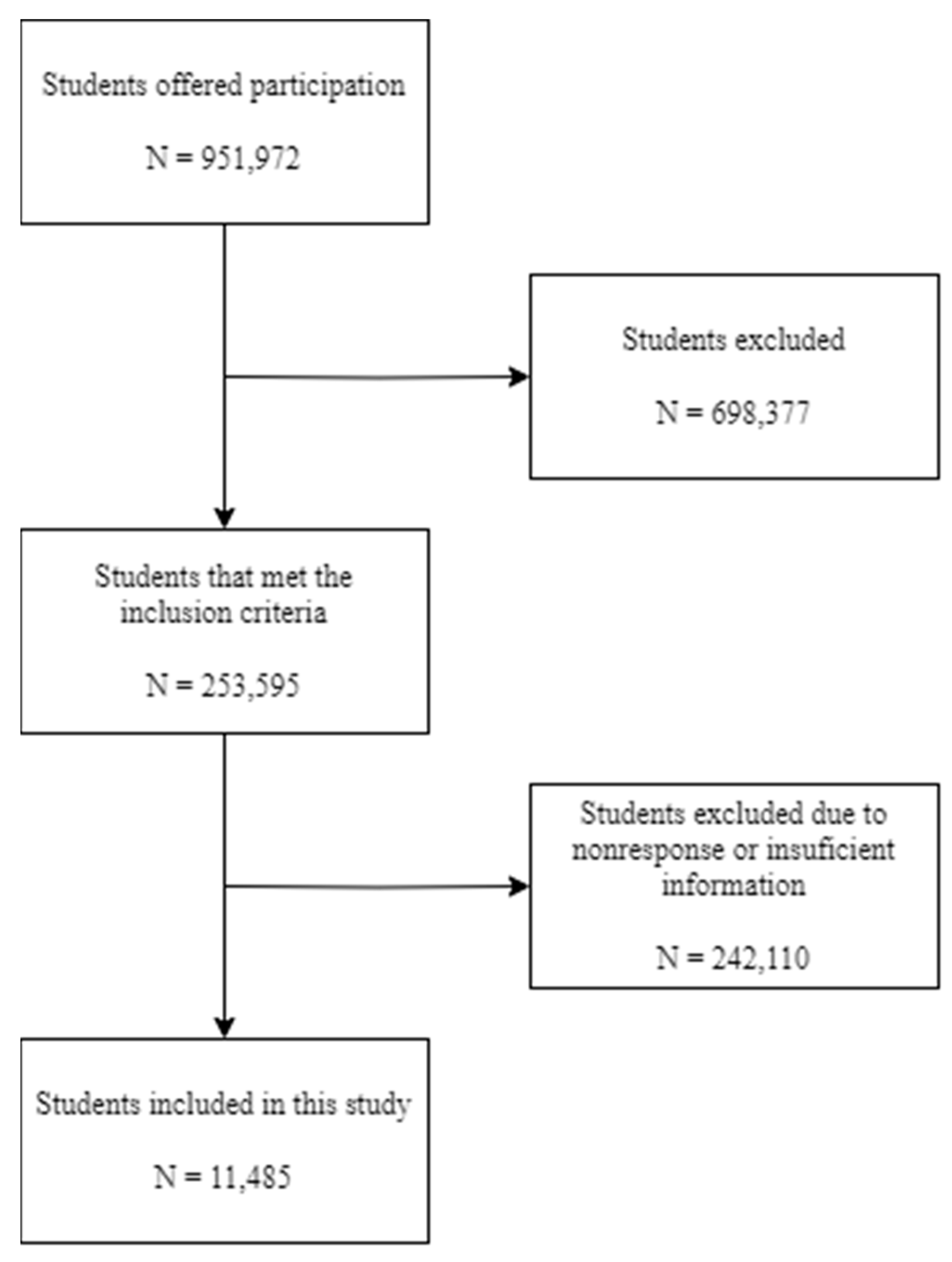
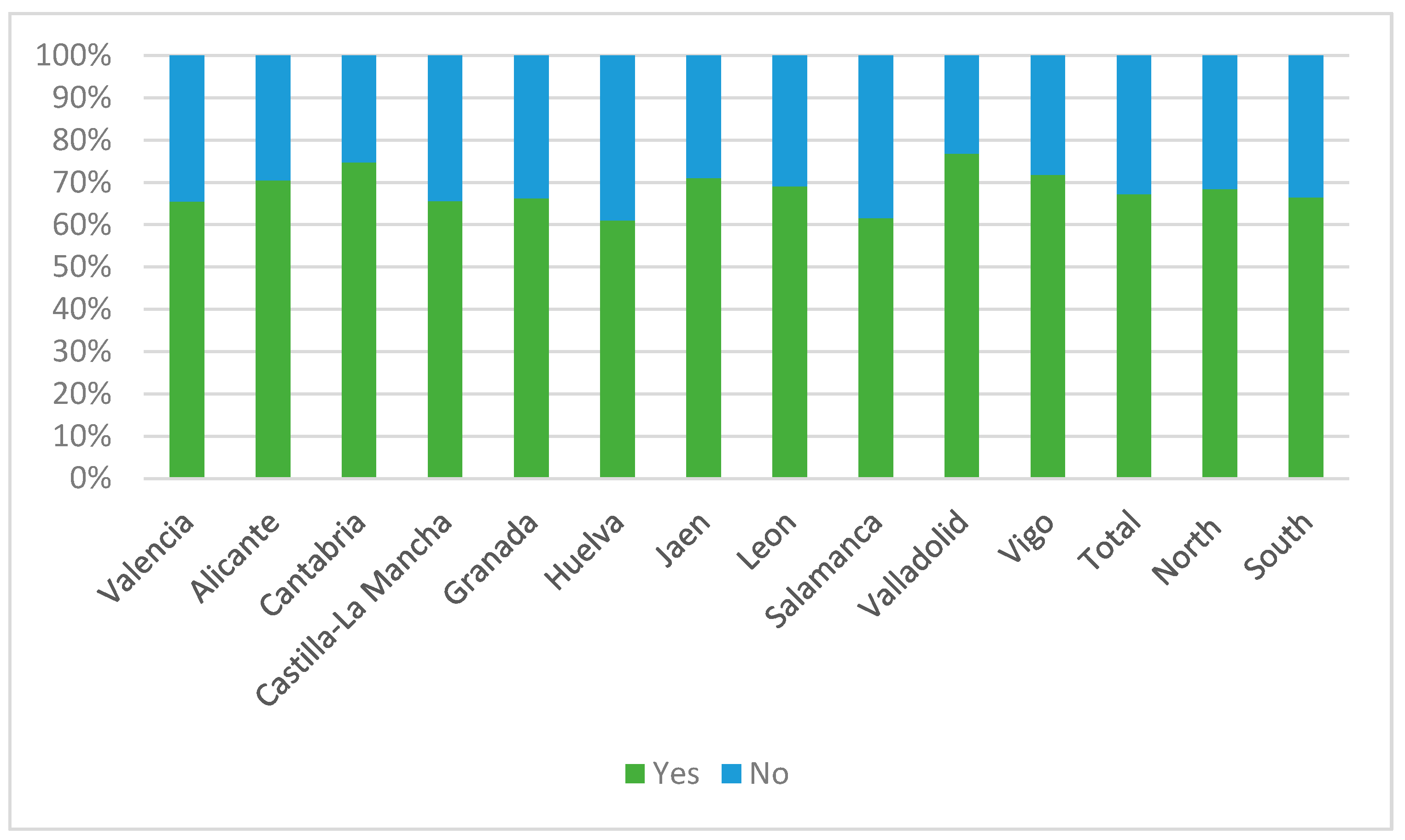
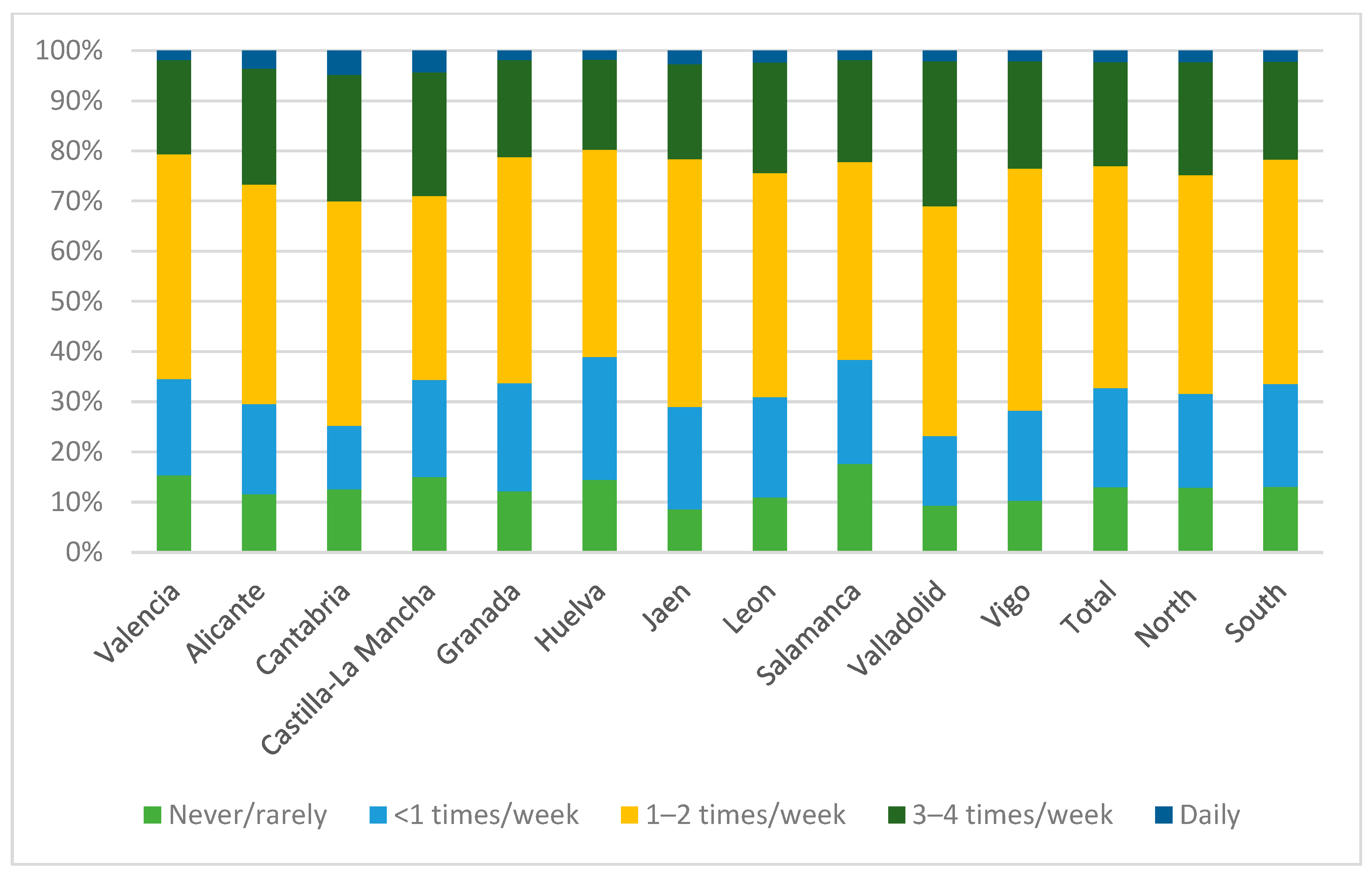
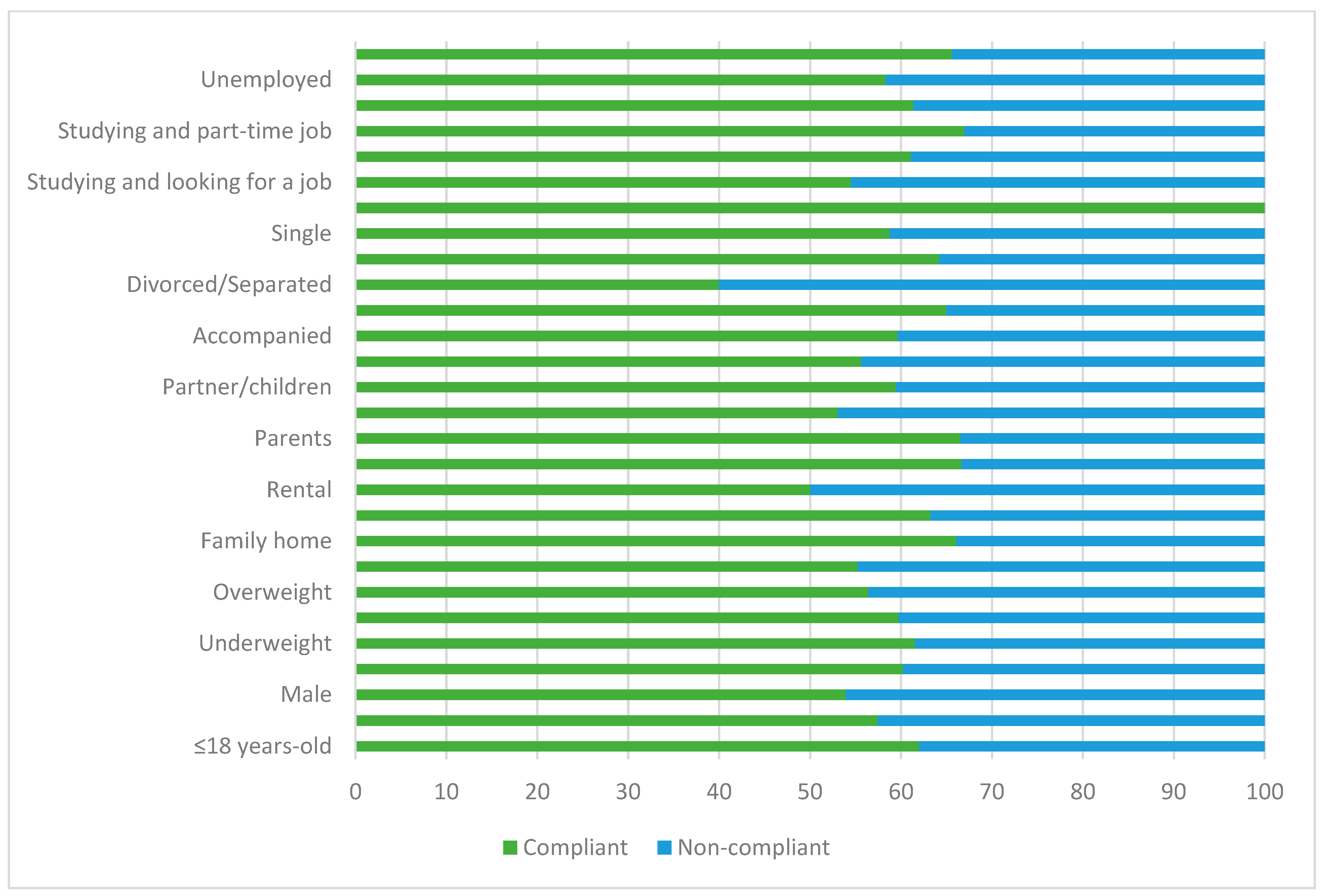
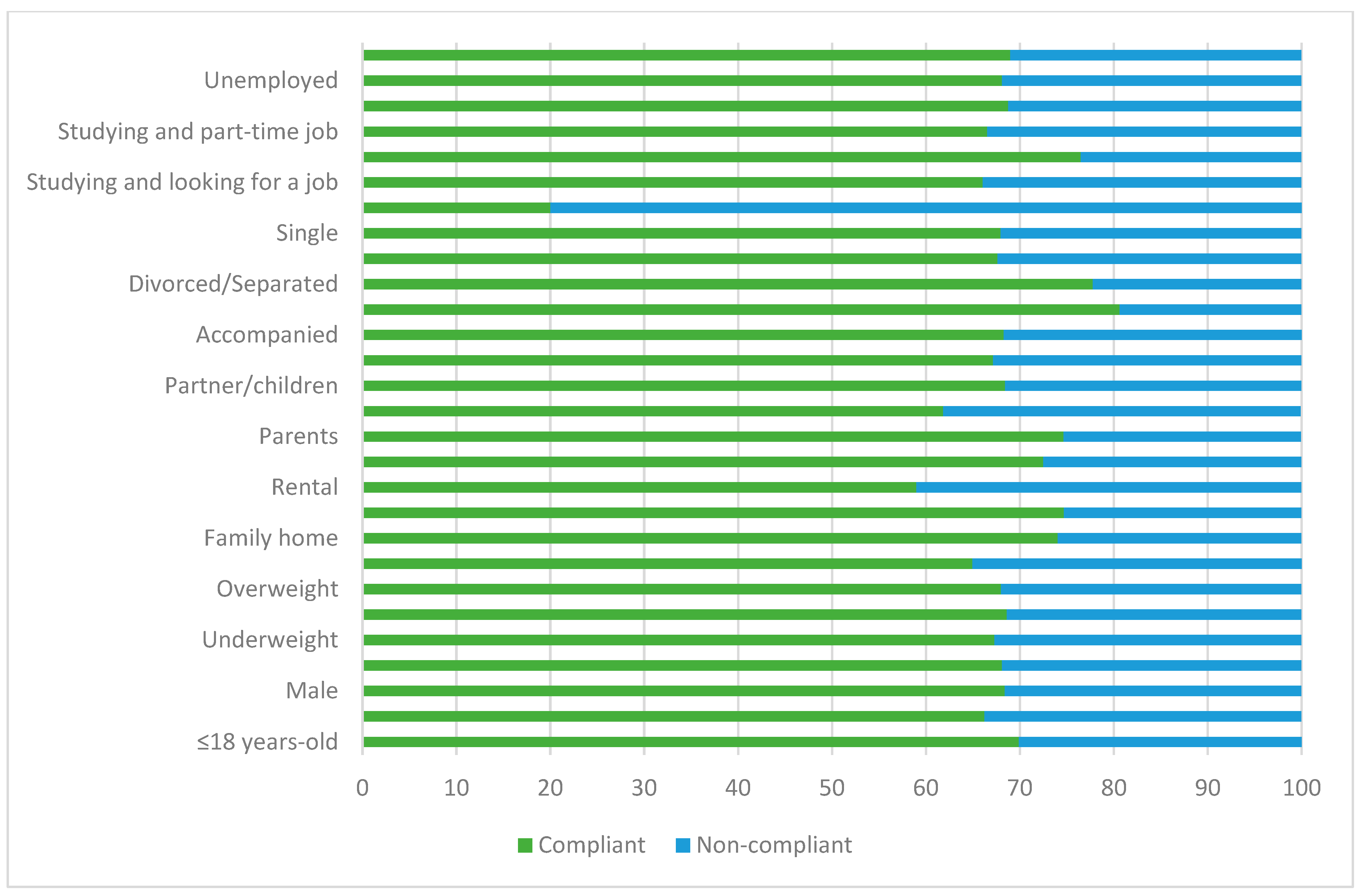
| Location | n (%) | 95% CI |
|---|---|---|
| Total | 11,485 (100) | 99.95–100 |
| North * | 4688 (40.8) | 39.91–41.72 |
| South ** | 6797 (59.2) | 58.27–60.08 |
| Valencia | 2057 (17.9) | 17.21–18.62 |
| Alicante | 974 (8.5) | 7.98–9.00 |
| Cantabria | 103 (0.9) | 0.73–1.08 |
| Castilla-La Mancha | 300 (2.6) | 2.33–2.9 |
| Granada | 2973 (25.9) | 25.08–26.69 |
| Huelva | 503 (4.4) | 4.01–4.77 |
| Jaén | 290 (2.5) | 2.24–2.83 |
| León | 1007 (8.8) | 8.29–9.30 |
| Salamanca | 1462 (12.7) | 12.12–13.35 |
| Valladolid | 616 (5.4) | 4.96–5.79 |
| Vigo | 1200 (10.4) | 9.89–11.03 |
| Total (n = 11,485) | Depression (n = 1207; 10.5%; 9.95–11.08) | No Depression (n = 10,278; 89.5%; 88.91–90.04) | p-Value * | ||||
|---|---|---|---|---|---|---|---|
| n (%)/ ± SD | 95% CI | n (%)/ ± SD | 95% CI | n (%)/ ± SD | 95% CI | ||
| Sex | |||||||
| Male | 3138 (27.3) | 26.5–28.14 | 191 (15.8) | 13.8–18.03 | 2947 (28.7) | 27.80–29.56 | 0.001 |
| Female | 8347 (72.7) | 71.85–73.49 | 1016 (84.2) | 81.96–86.16 | 7331 (71.3) | 70.44–72.19 | |
| Age | |||||||
| Male | 5.17 | 20.32–20.62 | 5.03 | 20.63–21.93 | 5.18 | 20.26–20.59 | 0.001 |
| Female | 4.38 | 19.92–20.02 | 5.27 | 20.84–21.10 | 4.23 | 19.78–19.88 | |
| ≤18 years | 5937 (51.7) | 50.77–52.61 | 476 (39.4) | 36.67–42.26 | 5461 (53.13) | 52.16–54.10 | 0.001 |
| >18 years | 5548 (48.3) | 47.38–49.22 | 731 (60.5) | 57.73–63.32 | 4817 (46.86) | 45.89–47.83 | 0.001 |
| BMI | |||||||
| Underweight | 1147 (10.1) | 9.57–10.69 | 156 (13.2) | 11.36–15.31 | 991 (9.8) | 9.19–10.35 | 0.001 |
| Normalweight | 8114 (71.6) | 71.59–72.42 | 785 (66.5) | 63.74–69.2 | 7329 (72.2) | 71.30–73.05 | 0.001 |
| Overweight | 1651 (14.6) | 13.92–15.23 | 172 (14.6) | 12.63–16.75 | 1479 (14.6) | 13.88–15.26 | 0.983 |
| Obesity | 421 (3.7) | 3.37–4.08 | 67 (5.7) | 4.45–7.11 | 354 (3.5) | 3.14–3.85 | 0.001 |
| Housing | |||||||
| Family home | 5213 (45.4) | 44.55–46.3 | 528 (43.7) | 42.85–44.63 | 4685 (45.6) | 45.27–45.88 | 0.200 |
| University residence | 1303 (11.3) | 10.77–11.94 | 117 (9.7) | 9.17–10.23 | 1186 (11.5) | 11.34–11.73 | 0.060 |
| Rental | 4510 (39.3) | 38.98–39.33 | 496 (41.1) | 40.21–41.97 | 4014 (39.1) | 38.75–39.35 | 0.180 |
| Own home/other | 459 (3.8) | 3.88–4.11 | 66 (5.5) | 5.07–5.88 | 393 (3.8) | 3.7–3.94 | 0.005 |
| Coexistence | |||||||
| Parents | 4845 (42.2) | 41.89–42.47 | 466 (38.6) | 37.73–39.48 | 4379 (42.6) | 42.3–42.9 | 0.007 |
| Roommates | 4883 (42.5) | 42.23–42.80 | 479 (39.7) | 38.81–40.56 | 4404 (42.8) | 42.54–43.15 | 0.052 |
| Partner/children | 756 (6.58) | 6.44–6.72 | 138 (11.4) | 10.87–12.01 | 618 (6.0) | 5.86–6.16 | 0.001 |
| Alone | 1001 (8.7) | 8.55–8.88 | 124 (10.3) | 9.74–10.83 | 877 (8.5) | 8.36–8.7 | 0.038 |
| Accompanied | 10,484 (91.28) | 90.75–91.79 | 1083 (89.72) | 87.84–91.35 | 9401(91.46) | 90.90–91.99 | 0.043 |
| Marital status | |||||||
| Married | 180 (1.6) | 1.49–1.64 | 50 (4.1) | 3.79–4.51 | 160 (1.6) | 1.48–1.63 | 0.700 |
| Divorced/separated | 44 (0.4) | 0.28–0.51 | 10 (0.80) | 0.42–1.57 | 36 (0.35) | 0.24–0.49 | 0.024 |
| Domestic partner | 844 (7.3) | 7.19–7.50 | 96 (8.0) | 7.48–8.45 | 748 (7.3) | 7.12–7.43 | 0.350 |
| Single | 10,404 (90.6) | 90.41–90.75 | 1079 (89.4) | 88.82–89.9 | 9325 (90.7) | 90.54–90.90 | 0.142 |
| Widowed | 11 (0.1) | 0.07–0.11 | 2 (0.16) | 0.16–0.26 | 9 (0.08) | 0.07–0.108 | 0.643 |
| Employment status | |||||||
| Studying and looking for a job | 2632 (22.9) | 22.67–23.16 | 378 (31.3) | 30.49–32.15 | 2254 (21.9) | 21.67–22.18 | 0.679 |
| Studying and full-time job | 300 (2.6) | 2.52–2.70 | 36 (3.0) | 2.68–3.3 | 246 (2.39) | 2.30–2.48 | 0.210 |
| Studying and part-time job | 934 (8.1) | 7.97–8.29 | 115 (9.5) | 9.01–10.06 | 819 (8.0) | 7.8–8.13 | 0.066 |
| Only studying, not looking for a job | 7619 (66.3) | 66.06–66.61 | 678 (56.2) | 55.28–57.05 | 6941 (67.5) | 67.24–67.81 | 0.001 |
| Employment | |||||||
| Unemployed | 10,251 (89.2) | 89.07–89.43 | 1056 (87.5) | 86.88–88.07 | 9195 (89.4) | 89.27–89.64 | 0.042 |
| Employed | 1234 (10.7) | 10.56–10.92 | 151 (12.5) | 10.72–14.54 | 1065 (10.6) | 10.17–10.55 | 0.021 |
| Compliant | Non-Compliant | Attributable Fraction | |
|---|---|---|---|
| OR crude | 1 Ref. | 1.47 (1.31–1.67) | 32.0% (23.7–40.1) |
| ORa Sex | 1 Ref. | 1.47 (1.30–1.66) | 32.0% (23.1–39.8) |
| ORa Sex, age | 1 Ref. | 1.44 (1.27–1.63) | 30.6% (21.3–38.7) |
| ORa Sex, age, BMI | 1 Ref. | 1.44 (1.27–1.63) | 30.6% (21.3–38.7) |
| ORa Sex, age, BMI, housing | 1 Ref. | 1.43 (1.26–1.62) | 30.1% (20.6–38.3) |
| ORa Sex, age, BMI, housing, coexistence | 1 Ref. | 1.45 (1.28–1.65) | 31.0% (21.9–39.4) |
| ORa Sex, age, BMI, housing, coexistence, marital status | 1 Ref. | 1.44 (1.27–1.63) | 30.6% (21.3–38.7) |
| ORa Sex, age, BMI, housing, coexistence, marital status, employment | 1 Ref. | 1.45 (1.28–1.64) | 31.0% (21.9–39.0) |
Disclaimer/Publisher’s Note: The statements, opinions and data contained in all publications are solely those of the individual author(s) and contributor(s) and not of MDPI and/or the editor(s). MDPI and/or the editor(s) disclaim responsibility for any injury to people or property resulting from any ideas, methods, instructions or products referred to in the content. |
© 2023 by the authors. Licensee MDPI, Basel, Switzerland. This article is an open access article distributed under the terms and conditions of the Creative Commons Attribution (CC BY) license (https://creativecommons.org/licenses/by/4.0/).
Share and Cite
Morales-Suárez-Varela, M.; Amezcua-Prieto, C.; Llopis-Gonzalez, A.; Ayan Perez, C.; Mateos-Campos, R.; Hernández-Segura, N.; Ortiz-Moncada, R.; Almaraz, A.; Alguacil, J.; Delgado Rodríguez, M.; et al. Prevalence of Depression and Fish Consumption among First Year Spanish University Students: UniHcos Project. Nutrients 2023, 15, 2757. https://doi.org/10.3390/nu15122757
Morales-Suárez-Varela M, Amezcua-Prieto C, Llopis-Gonzalez A, Ayan Perez C, Mateos-Campos R, Hernández-Segura N, Ortiz-Moncada R, Almaraz A, Alguacil J, Delgado Rodríguez M, et al. Prevalence of Depression and Fish Consumption among First Year Spanish University Students: UniHcos Project. Nutrients. 2023; 15(12):2757. https://doi.org/10.3390/nu15122757
Chicago/Turabian StyleMorales-Suárez-Varela, María, Carmen Amezcua-Prieto, Agustín Llopis-Gonzalez, Carlos Ayan Perez, Ramona Mateos-Campos, Natalia Hernández-Segura, Rocío Ortiz-Moncada, Ana Almaraz, Juan Alguacil, Miguel Delgado Rodríguez, and et al. 2023. "Prevalence of Depression and Fish Consumption among First Year Spanish University Students: UniHcos Project" Nutrients 15, no. 12: 2757. https://doi.org/10.3390/nu15122757
APA StyleMorales-Suárez-Varela, M., Amezcua-Prieto, C., Llopis-Gonzalez, A., Ayan Perez, C., Mateos-Campos, R., Hernández-Segura, N., Ortiz-Moncada, R., Almaraz, A., Alguacil, J., Delgado Rodríguez, M., Blázquez Abellán, G., Alonso-Molero, J., Martínez-Ruiz, V., Santana-Garcia, I., Cancela, J. M., Valero Juan, L. F., Martín-Peláez, S., Fernández-Villa, T., & Grupo de Investigación UniHcos. (2023). Prevalence of Depression and Fish Consumption among First Year Spanish University Students: UniHcos Project. Nutrients, 15(12), 2757. https://doi.org/10.3390/nu15122757












